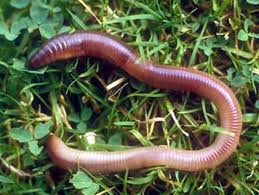
Common Earthworm
Fast Facts[]
- Type
- Invertebrate
- Diet
- Herbivore
- Average life span in the wild
- Up to 6 to 10 years
- Size
- Up to 14 in (35 cm)
- Weight
- Up to 0.39 oz (11.2 g)
- Did you know?
- Contrary to playground legend, if a worm is cut in half, two will not grow.
The reddish-gray-colored common earthworm, often called a night crawler in the United States, is familiar to anyone with a fishing rod or a garden. They are indigenous to Europe, but are now abundant in North America and western Asia.
Typically only a few inches (7 or 8 centimeters) in length, some members of this species have been known to grow to a serpentine 14 inches (35 centimeters). Earthworms’ bodies are made up of ring-like segments called annuli. These segments are covered in setae, or small bristles, which the worm uses to move and burrow.
Night crawlers are so named because they are usually seen feeding above ground at night. They burrow during the day—typically keeping close to the surface—capable of digging down as deep as 6.5 feet (2 meters).
The worm’s first segment contains its mouth. As they burrow, they consume soil, extracting nutrients from decomposing organic matter like leaves and roots. Earthworms are vital to soil health because they transport nutrients and minerals from below to the surface via their waste, and their tunnels aerate the ground. An earthworm can eat up to one third its body weight in a day.
Night crawlers also mate on the surface. They are hermaphroditic but do not self-fertilize. Following mating, each worm forms a tiny, lemon-shaped cocoon out of a liquid secreted from its clitellum, the familiar-looking bulge seen near the first third of the earthworm’s body. The sperm and egg cells are deposited inside the cocoon, and it is buried. After a two- to four-week gestation period, the baby worms emerge.
Earthworms are a source of food for numerous animals, like birds, rats, and toads, and are frequently used in residential composting and as bait in commercial and recreational fishing. Their numbers are strong throughout their range—they’re even considered agricultural pests in some areas—and they have no special status.
'''''Earthworms’ bodies are made up of ring-like segments called annuli. The annuli are covered in small hairs that help in moving and burrowing.'''''